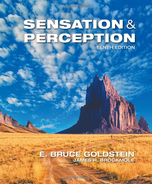Solution Found!
Texture Gradients: Shaping Our Depth Perception
Chapter 10, Problem 2(choose chapter or problem)
Texture gradients are said to provide information for depth perception because elements in a scene become more densely packed as distance increases. The examples of texture gradients in Figures 10.6 and 10.8 contain regularly spaced elements that extend over large distances. But regularly spaced elements are more the exception than the rule in the environment. Make an informal survey of your environment, both inside and outside, and decide
(a) whether texture gradients are present in your environment and
(b) if you think the principle behind texture gradients could contribute to the perception of depth even if the texture information in the environment is not as obvious as in the examples in this chapter. (p. 231)
Questions & Answers
QUESTION:
Texture gradients are said to provide information for depth perception because elements in a scene become more densely packed as distance increases. The examples of texture gradients in Figures 10.6 and 10.8 contain regularly spaced elements that extend over large distances. But regularly spaced elements are more the exception than the rule in the environment. Make an informal survey of your environment, both inside and outside, and decide
(a) whether texture gradients are present in your environment and
(b) if you think the principle behind texture gradients could contribute to the perception of depth even if the texture information in the environment is not as obvious as in the examples in this chapter. (p. 231)
ANSWER:Step 1 of 3
a.)
In my environment, indoors and outdoors, I can observe various texture gradients that could contribute to the perception of depth. While the examples provided in Figures 10.6 and 10.8 may contain regularly spaced elements over large distances, regularly spaced elements are more the exception than the rule in the real world. Nonetheless, other texture gradients can still provide depth cues even if the texture information is not as obvious as in those examples. Here are my observations:
Indoor Environment:
1. Flooring: In rooms with tiled or wooden floors, the texture of the flooring can create a texture gradient. As the flooring extends away from the observer, the size and spacing of the tiles or wood grains may appear to decrease, creating a sense of depth.
2. Walls: Textured walls, such as those with a stucco finish or wallpaper patterns, can exhibit a texture gradient. As the wall extends into the distance, the texture pattern becomes smaller and less distinct, giving a depth perception.
3. Bookshelves: If rows of books or objects are on shelves, the spacing between them can create a texture gradient. As the shelves recede into the distance, the gaps between the books or objects may appear narrower, indicating depth.
Watch The Answer!
Texture Gradients: Shaping Our Depth Perception
Want To Learn More? To watch the entire video and ALL of the videos in the series:
Discover how texture gradients shape our depth perception both indoors and outdoors. Explore how various environmental patterns provide depth cues. Understand the blend of Gestalt principles and depth cues in shaping our visual experience.
